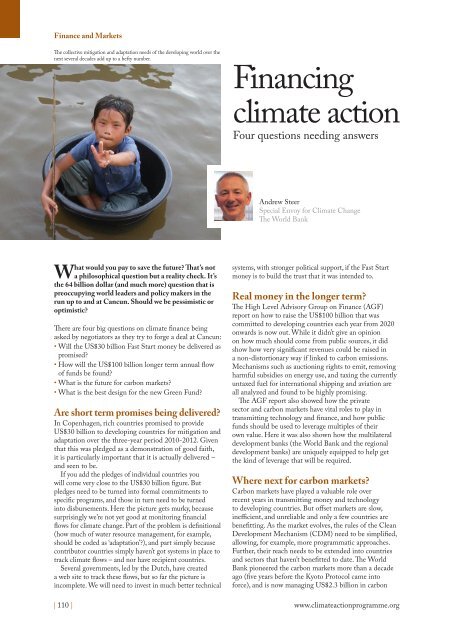Climate Action 2010-2011
Create successful ePaper yourself
Turn your PDF publications into a flip-book with our unique Google optimized e-Paper software.
Finance and Markets<br />
The collective mitigation and adaptation needs of the developing world over the<br />
next several decades add up to a hefty number.<br />
Financing<br />
climate action<br />
Four questions needing answers<br />
Andrew Steer<br />
Special Envoy for <strong>Climate</strong> Change<br />
The World Bank<br />
What would you pay to save the future? That’s not<br />
a philosophical question but a reality check. It’s<br />
the 64 billion dollar (and much more) question that is<br />
preoccupying world leaders and policy makers in the<br />
run up to and at Cancun. Should we be pessimistic or<br />
optimistic?<br />
There are four big questions on climate finance being<br />
asked by negotiators as they try to forge a deal at Cancun:<br />
• Will the US$30 billion Fast Start money be delivered as<br />
promised?<br />
• How will the US$100 billion longer term annual flow<br />
of funds be found?<br />
• What is the future for carbon markets?<br />
• What is the best design for the new Green Fund?<br />
Are short term promises being delivered?<br />
In Copenhagen, rich countries promised to provide<br />
US$30 billion to developing countries for mitigation and<br />
adaptation over the three-year period <strong>2010</strong>-2012. Given<br />
that this was pledged as a demonstration of good faith,<br />
it is particularly important that it is actually delivered –<br />
and seen to be.<br />
If you add the pledges of individual countries you<br />
will come very close to the US$30 billion figure. But<br />
pledges need to be turned into formal commitments to<br />
specific programs, and those in turn need to be turned<br />
into disbursements. Here the picture gets murky, because<br />
surprisingly we’re not yet good at monitoring financial<br />
flows for climate change. Part of the problem is definitional<br />
(how much of water resource management, for example,<br />
should be coded as ‘adaptation’?), and part simply because<br />
contributor countries simply haven’t got systems in place to<br />
track climate flows – and nor have recipient countries.<br />
Several governments, led by the Dutch, have created<br />
a web site to track these flows, but so far the picture is<br />
incomplete. We will need to invest in much better technical<br />
| 110 |<br />
systems, with stronger political support, if the Fast Start<br />
money is to build the trust that it was intended to.<br />
Real money in the longer term?<br />
The High Level Advisory Group on Finance (AGF)<br />
report on how to raise the US$100 billion that was<br />
committed to developing countries each year from 2020<br />
onwards is now out. While it didn’t give an opinion<br />
on how much should come from public sources, it did<br />
show how very significant revenues could be raised in<br />
a non-distortionary way if linked to carbon emissions.<br />
Mechanisms such as auctioning rights to emit, removing<br />
harmful subsidies on energy use, and taxing the currently<br />
untaxed fuel for international shipping and aviation are<br />
all analyzed and found to be highly promising.<br />
The AGF report also showed how the private<br />
sector and carbon markets have vital roles to play in<br />
transmitting technology and finance, and how public<br />
funds should be used to leverage multiples of their<br />
own value. Here it was also shown how the multilateral<br />
development banks (the World Bank and the regional<br />
development banks) are uniquely equipped to help get<br />
the kind of leverage that will be required.<br />
Where next for carbon markets?<br />
Carbon markets have played a valuable role over<br />
recent years in transmitting money and technology<br />
to developing countries. But offset markets are slow,<br />
inefficient, and unreliable and only a few countries are<br />
benefitting. As the market evolves, the rules of the Clean<br />
Development Mechanism (CDM) need to be simplified,<br />
allowing, for example, more programmatic approaches.<br />
Further, their reach needs to be extended into countries<br />
and sectors that haven’t benefitted to date. The World<br />
Bank pioneered the carbon markets more than a decade<br />
ago (five years before the Kyoto Protocol came into<br />
force), and is now managing US$2.3 billion in carbon<br />
www.climateactionprogramme.org












